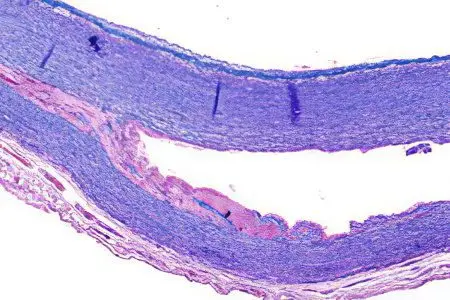Contents
Definition of the disease
Aortic dissection represents a great danger to human life, death occurs in most patients as a result of massive internal bleeding. Less commonly, strokes occur or acute heart failure develops as a complication of the process. Therefore, in the event of the first signs of aortic dissection, patients are immediately sent to the hospital.
Causes leading to aortic dissection
High blood pressure and atherosclerosis contribute to dissection of the aortic wall. Pathological changes in the connective tissue in diseases such as syphilis in the tertiary stage, congenital heart defects, are often one of the prerequisites for the development of the disease. Risk factors include smoking and late pregnancy. Not the last role is played by the hereditary factor.
Types of aortic dissection

The most common is proximal aortic dissection. As a rule, the process develops in the ascending aorta and may descend lower along the course of the blood vessel. Less often, a distal dissection is diagnosed, covering the descending section, sometimes continuing to the abdominal aorta.
The acute period of the disease can last up to 2 weeks, and if the patient survives this phase, the process, as a rule, becomes chronic.
Symptoms of aortic dissection
Elderly and older people most often suffer from this disease, although there are also cases of the disease among young people, more often associated with heredity or acquired pathological factors.
Aortic dissection can be both acute and have a protracted course. The acute form is characterized by a sudden rapid onset and a duration of up to 2 weeks. In the absence of correct and timely treatment, more than half of the patients die.
For all types of aortic dissection, there is a common symptom – this is severe pain, reminiscent of a myocardial infarction. As a result of impaired organ circulation, strokes can develop, patients develop severe shortness of breath, weakness increases, fainting may occur, and internal organs and systems suffer.
The proximal form is characterized by pains of a compressive or stabbing nature in the chest area, retrosternal space, often given to the back. The most intense manifestation of pain is noted at the beginning of the process. With further development of aortic dissection, ischemic disorders are observed in the upper limbs, brain and spinal cord.
In the distal form, pain occurs in the epigastric region, back and radiates to the neck. Further spread of the process causes ischemic lesions of the abdominal organs, kidneys, and lower extremities.
The patient’s condition in the acute period is always very difficult, critical. The state of shock is accompanied by an increase in blood pressure to maximum numbers and an increase in heart rate. A lethal outcome is inevitable in the absence of qualified assistance as a result of the development of acute heart failure or the onset of severe internal bleeding.
If the patient survived this stage of the disease, then the process becomes chronic and can last for a long time.
The chronic course of the disease is often asymptomatic or the clinical picture resembles an aortic aneurysm. But such patients should always remember that they are not immune from the sudden acute onset of aortic dissection or rupture.
Diagnosis of aortic dissection
In order to correctly recognize the diagnosis and differentiate from diseases of the cardiovascular system, a thorough history taking is necessary in combination with laboratory data. A chest x-ray is mandatory to determine structures within the body. The shape, movement and size of the heart are examined using an echocardiogram. Currently, computed tomography and MRI are widely used. Pictures of blood vessels are taken using aortography. All these methods allow us to establish the correct diagnosis with maximum accuracy.
Treatment of aortic dissection

Often the treatment of aortic dissection is carried out in the intensive care unit, where the patient is under constant supervision. The method of treatment is chosen depending on the type of disease. When blocking blood vessels, the surgical method is most often used; in the second option, surgical intervention is dispensed with. More than half of patients after treatment live more than 10 years.
With conservative treatment, the main emphasis is on lowering blood pressure to reduce the load on the aorta. In the future, patients are advised to undergo a medical examination every six months to a year to exclude an exacerbation of the disease.









